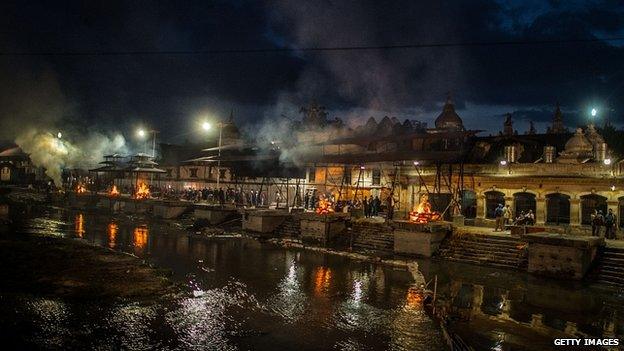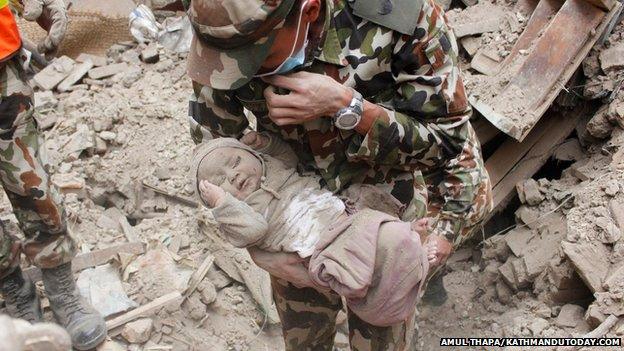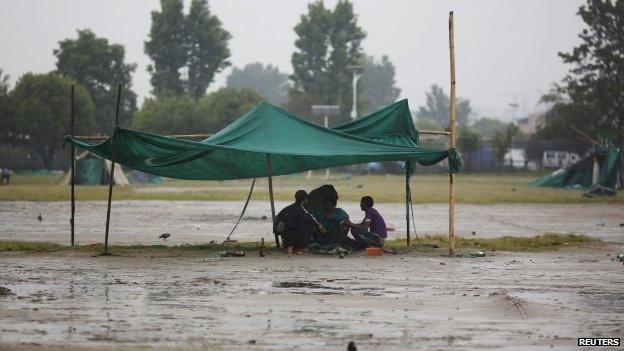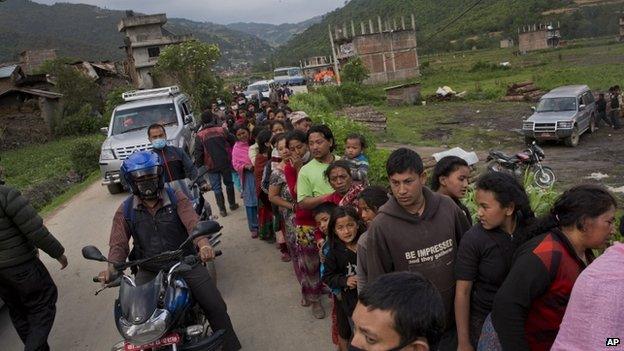Nepal earthquake: Two rescued after five days
- Published
Large crowds cheered as a teenager emerged from the rubble, as Yogita Limaye reports
Two people have been rescued from the rubble of buildings in Kathmandu, five days after an earthquake that killed more than 6,100 in Nepal.
A 15-year-old boy told the BBC he survived by drinking water from wet clothes and eating clarified butter.
Elsewhere, a woman was pulled from a collapsed block where she had been trapped alongside three bodies.
Meanwhile, bad weather is hampering the delivery of relief to remote villages, a Nepali government spokesman said.
The government has been criticised for its response to the disaster.
Outside Kathmandu, the relief effort has relied heavily on helicopters, with mountain roads blocked by landslides triggered by the earthquake.
Laxmi Dhakal, a spokesperson for Nepal's home ministry, told the BBC that helicopters had been held back by "rainfall and cloudy conditions".
Rescuers from five countries worked together to bring Nepal earthquake survivor, Krishna, from the rubble of a building - Clive Myrie reports
In Kathmandu, rescue workers from Nepal and the US worked for hours to free the boy from the rubble of the building.
A huge crowd cheered as Pemba Lama emerged, blinking into the sunlight.
He was carried away with a brace strapped around his neck, and was taken to an Israeli-run field hospital.
He later told the BBC: "There were so many people around me in the rubble. They were screaming."
Pemba Lama: "I saw two containers of butter and ate it to survive"
The woman, called Krishna and in her 20s, was working as a maid in a Kathmandu hostel when the quake struck.
The BBC's Clive Myrie, who was at the scene, says rescue teams from five different countries dug through the rubble for four hours to reach the woman who was awake but in a weak condition.
They attached a saline drip to her arm to rehydrate her, and a dead body had to be removed before she could be brought out. In all, the rescue took more than eight hours.
Survivors fall ill
On Wednesday night, Nepalese soldiers in the town of Bhaktapur, on the outskirts of Kathmandu, reportedly rescued an 11-year-old girl from earthquake rubble.
The girl was freed from a damaged building in the town's Dattatreya Square, according to a tweet, external from Kunda Dixit, the editor of the Nepali Times newspaper.
Meanwhile, medics say many who survived Saturday's 7.8-magnitude quake are now falling ill because they have been living in the open and drinking contaminated water.
Binay Pandey, a doctor at Kathmandu's Bir Hospital, said at least 1,200 people with water-borne illnesses had been admitted since Wednesday morning.

Hundreds of funeral pyres are being lit for victims of the earthquake

A four-month-old baby was plucked alive from the rubble earlier this week

There have been urgent appeals for food, water - and shelter
Climbing is expected to resume next week on Mount Everest, where avalanches triggered by the earthquake killed 18 people.
Damaged ladders in an area of the mountain known as the Khumbu icefall would be repaired within the next few days, according to the chief of Nepal's tourism department, Tulsi Gautam.
Frustration has been growing in parts of rural Nepal over the pace of relief efforts, with some badly-affected villages yet to receive any assistance.

Riot police faced an angry crowd in the capital, Kathmandu
Late on Thursday the government said the death toll had risen to 6,130 with 13,827 injured.
The UN says more than eight million people have been affected and about 70,000 houses destroyed.
Dozens of countries are supporting the aid operation, external, contributing search-and-rescue teams, aircraft, medical supplies and communications equipment.


There are long queues for food and water around the capital, Kathmandu

Despite extensive damage, experts say the number of casualties in many villages was lower than feared because people were working outdoors when the quake struck.
In Kathmandu, riot police clashed on Wednesday with protesters angry at a lack of transport out of the city and delays in distributing aid.
However, there have been some signs that parts of the capital are returning to normal.
Some people have decided to return to their homes, having spent several nights out in the open. Cash machines have been refilled and some shops and street vendors have once again started trading.
